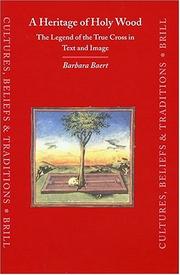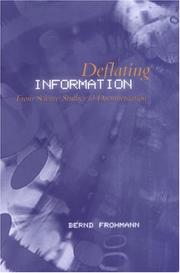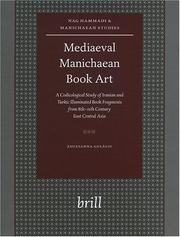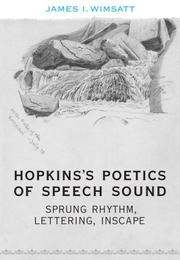| Listing 1 - 10 of 10 |
Sort by
|

ISBN: 9004139443 9786610915392 9047405749 1280915390 1429454725 9789004139442 9781429454728 9789047405740 Year: 2004 Volume: 22 Publisher: Leiden; Boston : BRILL,
Abstract | Keywords | Export | Availability | Bookmark
 Loading...
Loading...Choose an application
- Reference Manager
- EndNote
- RefWorks (Direct export to RefWorks)
In the fourth century the idea arose that the Cross on which Christ was crucified had been found by Helena, mother of Emperor Constantine. Thus began a legend that would grow and flourish throughout the Middle Ages and cause the diffusion of countless splinters of holy wood. And where there is wood, there was once a tree. Could it be that the Cross was made from that most noble species, the Tree of Life? So, gathering characters along the way, the legend evolved into a tale that stretches from the Creation to the End of Time. A Heritage of Holy Wood is the first reconstruction of the iconographic and literary tradition of the Legend of the True Cross. Its broad scope encompasses relic cults, pilgrimages, travellers' tales and the Tree of Life and involves Church Fathers, crusader kings, Teutonic Knights and mendicant orders, all of which influenced the legend's depiction from its earliest representation in manuscripts, reliquaries and altarpieces, to the great monumental cycles of the high Middle Ages. If the holy wood was the medium of medieval memory, A Heritage of Holy Wood reveals the growth rings of fifteen centuries of imagery.
Holy Cross --- Art, Byzantine. --- Art, Medieval. --- Legends --- Art [Byzantine ] --- Art [Medieval ] --- Art byzantin --- Art médiéval --- Byzantijnse kunst --- Byzantine art --- Kunst [Byzantijnse ] --- Kunst [Middeleeuwse ] --- Medieval art --- Middeleeuwse kunst --- Iconography --- Christian church history --- Christian special devotions --- anno 500-1499 --- 091.31:7.04 --- 246 --- Academic collection --- 091.31:7.04 Verluchte handschriften: iconografie --- Verluchte handschriften: iconografie --- Christelijke kunst en symbolisme --- Religion Art in Christianity --- Art, Byzantine --- Art, Medieval --- Sainte Croix --- Art médiéval --- Art --- Légendes --- Christian art and symbolism --- Cross --- Feast of the Cross --- Art. --- Holy Cross - Legends - Art.
Book
ISBN: 9068252526 9058260933 Year: 2000 Publisher: Leuven Davidsfonds
Abstract | Keywords | Export | Availability | Bookmark
 Loading...
Loading...Choose an application
- Reference Manager
- EndNote
- RefWorks (Direct export to RefWorks)
Overzicht van het dagelijks leven in al zijn facetten
Cultuurgeschiedenis. --- geschiedenis. --- Geschiedenis van Europa. --- anno 500-1499. --- History of civilization --- geschiedenis --- History of Europe --- anno 500-1499 --- 091 <4> --- 091 "04/14" --- 091.31:7.04 --- 930.85.42 --- dagelijks leven --- middeleeuwen (x) --- 906 --- 925 --- huiselijk leven --- maatschappelijk leven --- middeleeuwen --- Bloemlezingen --- Dagelijks leven --- Middeleeuwen --- Miniatuur --- 930.85.42 Cultuurgeschiedenis: Middeleeuwen --- Cultuurgeschiedenis: Middeleeuwen --- 091.31:7.04 Verluchte handschriften: iconografie --- Verluchte handschriften: iconografie --- 091 "04/14" Handschriftenkunde. Handschriftencatalogi--Middeleeuwen --- Handschriftenkunde. Handschriftencatalogi--Middeleeuwen --- 091 <4> Handschriftenkunde. Handschriftencatalogi--Europa --- Handschriftenkunde. Handschriftencatalogi--Europa --- huiselijk en maatschappelijk leven --- geschiedenis - Middeleeuwen --- Historische verhalen --- Sociaal leven --- Geschiedenis --- Historisch verhaal --- Geneeskunde --- Techniek (wetenschap) --- Atlas --- Museum --- Kunstgeschiedenis --- Antropologie
Book
ISBN: 9789004250031 9789004250833 9004250832 9004250034 129982952X Year: 2013 Volume: 28 5 Publisher: Leiden ; Boston : Brill,
Abstract | Keywords | Export | Availability | Bookmark
 Loading...
Loading...Choose an application
- Reference Manager
- EndNote
- RefWorks (Direct export to RefWorks)
The "Vows of the Peacock" - written in 1312 and dedicated to Thibaut de Bar, bishop of Liège - recounts how Alexander the Great comes to the aid of a family of aristocrats threatened by Indians. The poem remained popular throughout the fourteenth century and was soon followed by two sequels. Twenty-six illuminated manuscripts constitute part of a catalogue and concordance of all Peacock manuscripts. One of the most provocative, (PML, MS G24), has twenty-two miniatures which illustrate chivalry and courtly love, as epitomized in the text. An unusually high number of scurrilous marginalia, however, surround them. An interdisciplinary exploration of iconography, reception, image-text-marginalia dynamics, and context reveals their ultimate polysemy as scatological comedians and serious harbingers of sin.
Book history --- Old French literature --- Manuscripts. Epigraphy. Paleography --- anno 1300-1399 --- 091 <73 NEW YORK> --- 091.31:7.04 --- Handschriftenkunde. Handschriftencatalogi--Verenigde Staten van Amerika. VSA. USA--NEW YORK --- Verluchte handschriften: iconografie --- 091.31:7.04 Verluchte handschriften: iconografie --- 091 <73 NEW YORK> Handschriftenkunde. Handschriftencatalogi--Verenigde Staten van Amerika. VSA. USA--NEW YORK --- Illumination of books and manuscripts, Medieval --- Manuscripts, French --- Marginal illustrations --- Illustrations, Marginal --- Marginal scenes --- Scenes, Marginal --- Illumination of books and manuscripts --- French manuscripts --- Painting, Medieval --- Alexander, --- Brisebare, --- Jacques, --- Alejandro, --- Alekjhāṇḍara, --- Aleksandar, --- Aleksander, --- Aleksandr, --- Alekʻsandre, --- Aleksandros bar Filipos, --- Aleksandŭr, Makedonski, --- Alessandro, --- Alexander --- Alexandre, --- Alexandros --- Alexandros, --- Alexandros, Megalos, --- Alexandru, --- Alexantros, --- Aleksandŭr, --- Александър, --- Iskandar, --- Maḳdonya, Aleksandros bar Filipos, --- Makedonski, Aleksandŭr, --- Македонски, Александър, --- Megalexandros, --- Megas Alexandros, --- Nagy Sándor, --- Sikandar, --- Iskender, --- Μέγας Ἀλέξανδρος, --- Ἀλέξανδρος, --- Ἀλέξανδρος --- אלכסנדר בן פיליפוס, --- אלכסנדר, --- اسكندر كبير --- اسکندر اعظم --- سکندراعظم --- Romances --- History and criticism. --- Illustrations. --- Pierpont Morgan Library. --- Illumination of books and manuscripts, Medieval. --- Marginal illustrations.

ISBN: 0802088392 0802048196 9786611994792 144267377X 1281994790 9781442673779 9781281994790 9780802088390 Year: 2004 Publisher: Toronto Buffalo University of Toronto Press
Abstract | Keywords | Export | Availability | Bookmark
 Loading...
Loading...Choose an application
- Reference Manager
- EndNote
- RefWorks (Direct export to RefWorks)
Is disseminating information the main purpose of scholarly scientific literature? Recent work in science studies signals a shift of emphasis from conceptual to material sources, from thinking to doing, and from representing the world to intervening in it. Scientific knowledge production is no longer seen as a process of seeking, collecting, organizing, and processing abstract elements, but instead one of assembling the many different material 'bits and pieces' of scientific culture in order to make things work. In Deflating Information, Bernd Frohmann draws on recent work in the social studies of science, finding the most significant material in the coordination of research work, the stabilization of matters of fact, and the manufacture of objectivity. Arguing for a 'deflationary' account of information, Frohmann challenges the central concept of information studies, thereby laying a foundation for a documentalist approach to emerging issues in the field.
Communicatie in de wetenschap --- Communication dans les sciences --- Communication in research --- Communication in science --- Communication scientifique --- Communications scientifiques --- Documentatie --- Documentation --- Informatiewetenschappen --- Information [Sciences de l'] --- Information science --- Science communication --- Science information --- Sciences de l'information --- Scientific communications --- #SBIB:044.IOS --- #SBIB:316.23H2 --- Sociologie van de wetenschappen --- Communication in science. --- Documentation. --- Information science. --- Science --- Sciences de l'information. --- Sciences --- Methodology. --- Social aspects. --- Aspect social. --- Scientific method --- Science and society --- Sociology of science --- Logic, Symbolic and mathematical --- Communication --- Information literacy --- Library science --- Information services --- Methodology --- Social aspects --- 091.31:7.04 --- 091 <456.31> --- 091 VERGILIUS MARO, PUBLIUS --- 091.31 <45> --- 091 =71 --- 091.31:7.04 Verluchte handschriften: iconografie --- Verluchte handschriften: iconografie --- 091 =71 Handschriftenkunde. Handschriftencatalogi--Latijn --- Handschriftenkunde. Handschriftencatalogi--Latijn --- 091.31 <45> Verluchte handschriften--Italië --- Verluchte handschriften--Italië --- 091 VERGILIUS MARO, PUBLIUS Handschriftenkunde. Handschriftencatalogi--VERGILIUS MARO, PUBLIUS --- Handschriftenkunde. Handschriftencatalogi--VERGILIUS MARO, PUBLIUS --- 091 <456.31> Handschriftenkunde. Handschriftencatalogi--Vaticaanstad. Kerkelijke Staat --- Handschriftenkunde. Handschriftencatalogi--Vaticaanstad. Kerkelijke Staat
Book
ISSN: 2509310X ISBN: 3319567845 9783319567839 3319567837 Year: 2017 Publisher: Cham : Springer International Publishing : Imprint: Springer,
Abstract | Keywords | Export | Availability | Bookmark
 Loading...
Loading...Choose an application
- Reference Manager
- EndNote
- RefWorks (Direct export to RefWorks)
This carefully researched monograph is a historical investigation of the illustrated Aratea astronomical manuscript and its many interpretations over the centuries. Aratus' 270 B.C.E. Greek poem describing the constellations and astrological phenomena was translated and copied over 800 years into illuminated manuscripts that preserved and illustrated these ancient stories about the constellations. The Aratea survives in its entirety due to multiple translations from Greek to Latin and even to Arabic, with many illuminated versions being commissioned over the ages. The survey encompasses four interrelated disciplines: history of literature, history of myth, history of science, and history of art. Aratea manuscripts by their nature are a meeting place of these distinct branches, and the culling of information from historical literature and from the manuscripts themselves focuses on a wider, holistic view; a narrow approach could not provide a proper prospective. What is most essential to know about this work is that because of its successive incarnations it has survived and been reinterpreted through the centuries, which speaks to its importance in all of these disciplines. This book brings a better understanding of the history, changes and transmission of the original astronomical Phaenomena poem. Historians, art historians, astronomy lovers, and historians of astronomy will learn more specialized details concerning the Aratea and how the tradition survived from the Middle Ages. It is a credit to the poetry of Aratus and the later interpreters of the text that its pagan aspects were not edited nor removed, but respected and maintained in the exact same form despite the fact that all sixty Aratea manuscripts mentioned in this study were produced under the rule of Christianity.
Physics. --- History. --- Literature, Medieval. --- Observations, Astronomical. --- Astronomy --- Astronomy, Observations and Techniques. --- History of Science. --- Medieval Literature. --- History and Philosophical Foundations of Physics. --- Observations. --- Manuscripts, Medieval. --- Astronomy, Greek, in literature. --- Aratus, --- 091:52 --- 091:133.52 --- 091:133.52 Handschriften i.v.m. astrologie --- Handschriften i.v.m. astrologie --- 091:52 Handschriften i.v.m. astronomie-- Zie ook: {091:133.52} --- Handschriften i.v.m. astronomie-- Zie ook: {091:133.52} --- 091.31:7.04 --- 091.31:7.04 Verluchte handschriften: iconografie --- Verluchte handschriften: iconografie --- Natural philosophy --- Philosophy, Natural --- Physical sciences --- Dynamics --- Astronomical observations --- Observations, Astronomical --- European literature --- Medieval literature --- Annals --- Auxiliary sciences of history --- Medieval manuscripts --- Manuscripts --- Astronomy—Observations. --- Science—History. --- Physics—Philosophy. --- Philosophical Foundations of Physics and Astronomy.

ISBN: 900413994X 9786610859924 1429427906 904740596X 128085992X 1433707098 Year: 2005 Volume: 57 Publisher: Leiden ; Boston : Brill,
Abstract | Keywords | Export | Availability | Bookmark
 Loading...
Loading...Choose an application
- Reference Manager
- EndNote
- RefWorks (Direct export to RefWorks)
Mediaeval Manichean Book Art focuses on a corpus of c. one hundred fragments of exquisitely illuminated manuscripts that were produced under the patronage of the Turkic-speaking Uygurs in the Turfan region of East Central Asia between the 8th and 11th centuries CE, and used in service of the local Manichaean church. By applying a codicological approach to the analysis of these sources, this study casts light onto a lost episode of Central Asian art history and religious book culture. Each of the five chapters in this book accomplishes a well-defined goal. The first justifies the formation of the corpus . The second examines its dating on the basis of scientific and historical evidence. Chapter three assesses the artistry of their bookmakers, scribes, and illuminators. The fourth documents the patterns of page layout preserved on the fragments. The final chapter analyses the contextual relationship of their painted and written contents . Mediaeval Manichaean Book Art represents a pioneer study in its subject, research methodology, and illustrations. It extracts codicological and art historical data from torn remains of lavishly decorated Middle-Persian, Sogdian, and Uygur language manuscripts in codex, scroll, and "palm-leaf" formats. Through detailed analyses and carefully argued interpretations aided by precise computer drawings, the author introduces an important group of primary sources for future comparative research in Central Asian art, mediaeval book illumination, and Manichaean studies.
Illumination of books and manuscripts, Manichaean --- Illumination of books and manuscripts, Medieval --- 091 =915 --- 091 =943 --- 091 <43 BERLIN> --- 091.31:7.04 --- 091.31:75.033.3 --- 273.21 --- 091.14 --- 091.14 Codicologie. Codices. Scriptoria --- Codicologie. Codices. Scriptoria --- 273.21 Manicheïsme --- Manicheïsme --- 091.31:7.04 Verluchte handschriften: iconografie --- Verluchte handschriften: iconografie --- 091 =943 Handschriftenkunde. Handschriftencatalogi--Turks --- Handschriftenkunde. Handschriftencatalogi--Turks --- 091 =915 Handschriftenkunde. Handschriftencatalogi--Iraans. Perzisch --- Handschriftenkunde. Handschriftencatalogi--Iraans. Perzisch --- 091.31:75.033.3 Verluchte handschriften-:-Schilderkunst--?.033.3 --- Verluchte handschriften-:-Schilderkunst--?.033.3 --- 091 <43 BERLIN> Handschriftenkunde. Handschriftencatalogi--Duitsland voor 1945 en na 1989--BERLIN --- Handschriftenkunde. Handschriftencatalogi--Duitsland voor 1945 en na 1989--BERLIN --- Painting, Medieval --- Manichaean illumination of books and manuscripts --- Illumination of books and manuscripts

ISBN: 1281992097 9786611992095 1442675861 9781442675865 0802091547 9780802091543 0802085113 9781281992093 661199209X Year: 2006 Publisher: Toronto, Ont. Buffalo, NY University of Toronto Press
Abstract | Keywords | Export | Availability | Bookmark
 Loading...
Loading...Choose an application
- Reference Manager
- EndNote
- RefWorks (Direct export to RefWorks)
Although virtually unknown in his lifetime, Gerard Manley Hopkins (1844?1889) is counted today among the great nineteenth-century poets. His poetry was collected and published posthumously by his friend Robert Bridges in 1917, and subsequently Hopkins?s reputation flowered, though more as a modern writer than as Victorian, and very little as a poetic theorist. Yet the body of Hopkins?s critical writing reveals sharp insight into the subject of poetics, and presents an innovative theory that locates primary poetic meaning in ?figures of speech sound.? These ?figures of speech sound? provide the focus for James I. Wimsatt?s erudite and original study. Drawing from Hopkins?s diaries, letters, student essays, and correspondence with poet-friends, Wimsatt illuminates Hopkins?s theory that the sound of poetic language carries an emotional, not merely logical and grammatical, meaning. Wimsatt concentrates his study on Hopkins?s writings about ?sprung rhythm,? ?lettering,? and ?inscape,? ? his coinages ? and makes abundant reference to Hopkins?s verse, showing how it exemplifies his language theory. A well-researched and highly detailed book, Hopkins?s Poetics of Speech Sound asserts major significance for a relatively neglected aspect of this important poet?s writings.
Poetics. --- Poetry --- Technique --- Hopkins, Gerard Manley, --- Hopkins, G. M. --- Hopkins, Manley, --- Versification. --- Poetics --- 820 "18" HOPKINS, GERARD MANLEY --- 820 "18" HOPKINS, GERARD MANLEY Engelse literatuur--19e eeuw. Periode 1800-1899--HOPKINS, GERARD MANLEY --- Engelse literatuur--19e eeuw. Periode 1800-1899--HOPKINS, GERARD MANLEY --- Hopkins, Gerard Manley --- 091.31:7.04 --- 091 <41 LONDON> --- 091:52 --- #BIBC:CANADIANA 2002 --- 091:52 Handschriften i.v.m. astronomie-- Zie ook: {091:133.52} --- Handschriften i.v.m. astronomie-- Zie ook: {091:133.52} --- 091 <41 LONDON> Handschriftenkunde. Handschriftencatalogi--Verenigd Koninkrijk van Groot-Brittannië en Noord-Ierland--LONDON --- Handschriftenkunde. Handschriftencatalogi--Verenigd Koninkrijk van Groot-Brittannië en Noord-Ierland--LONDON --- 091.31:7.04 Verluchte handschriften: iconografie --- Verluchte handschriften: iconografie
Book
ISBN: 9004283064 9789004283060 9004269185 9789004269187 9789004269187 9004269185 Year: 2016 Publisher: Leiden, Netherlands ; Boston, [Massachusetts] : Brill,
Abstract | Keywords | Export | Availability | Bookmark
 Loading...
Loading...Choose an application
- Reference Manager
- EndNote
- RefWorks (Direct export to RefWorks)
In Imagining the Text , James Brown examines ekphrasis – the verbal representation of a visual representation – in Wirnt von Gravenberg’s thirteenth-century Arthurian romance Wigalois , one of the most popular and enduring stories in the Middle High German literary tradition. Through close reading of the text and examining illustrated Wigalois manuscripts, early print editions, and frescoes, Brown explores how ekphrasis structures the narrative, harmonizes potential conflicts in the text, and contributes to the construction of courtly identity. Imagining the Text demonstrates that the vibrant symbiosis of word and image is crucial to the poem’s sustained popularity for more than six hundred years, and contributes to the history of the book and to the study of medieval and modern modes of perception.
Ekphrasis. --- Knights and knighthood in literature. --- Guinglain (Legendary character) --- Arthurian romances --- Ecphrasis --- Art in literature --- Description (Rhetoric) --- Romances --- History and criticism. --- Wirnt, --- 091 =30 --- 094:801 --- 094:82-34 --- 091.31:7.04 --- 091.31:7.04 Verluchte handschriften: iconografie --- Verluchte handschriften: iconografie --- 094:82-34 Oude en merkwaardige drukken. Kostbare en zeldzame boeken. Preciosa en rariora-:-Sprookje. Legende. Mythe --- Oude en merkwaardige drukken. Kostbare en zeldzame boeken. Preciosa en rariora-:-Sprookje. Legende. Mythe --- 094:801 Oude en merkwaardige drukken. Kostbare en zeldzame boeken. Preciosa en rariora-:-Algemene taalwetenschap. Filologie --- Oude en merkwaardige drukken. Kostbare en zeldzame boeken. Preciosa en rariora-:-Algemene taalwetenschap. Filologie --- 091 =30 Handschriftenkunde. Handschriftencatalogi--Duits --- Handschriftenkunde. Handschriftencatalogi--Duits --- Wirnt von Grafenberg --- Guinglain --- Bel Inconnu --- Fair Unknown --- Gingalain --- Gingalin --- Gliglois --- Libeaus --- Viduvilt --- Wieduwilt --- Wigalois
Book
ISBN: 9789004201002 9004201009 9786613334879 1283334879 9004222650 9789004222656 Year: 2012 Publisher: Leiden Boston Brill
Abstract | Keywords | Export | Availability | Bookmark
 Loading...
Loading...Choose an application
- Reference Manager
- EndNote
- RefWorks (Direct export to RefWorks)
The Kitāb Naʿt al-Ḥayawān is the earliest of a group of illustrated manuscripts dealing with the characteristics of animals and their medicinal uses. The present study considers both the confluence of textual traditions within this work and the stylistic and iconographic relationships of its illustrations, which make it a key witness to early thirteenth-century Arab painting. After a re-evaluation of previous approaches, emphasis is placed on relating image to text, on stylistic affiliations, and on the modalities of production, supported by technical analyses undertaken for the first time. In elucidating the particular context of this unique manuscript, the study contributes to our understanding of a critical period in the development of Middle Eastern painting and art.
Book history --- Graphic arts --- anno 1200-1299 --- Arab States --- Bestiaries --- Animals in art. --- Illumination of books and manuscripts, Arab. --- Islamic illumination of books and manuscripts. --- Illumination of books and manuscripts, Medieval --- History and criticism. --- Naʻt al-ḥayawān --- Geschichte 1200-1300. --- 091 =927 --- 091:61 --- 091.31:7.04 --- 091 "12" --- Handschriftenkunde. Handschriftencatalogi--Arabisch --- Handschriften i.v.m. geneeskunde --- Verluchte handschriften: iconografie --- Handschriftenkunde. Handschriftencatalogi--13e eeuw. Periode 1200-1299 --- 091 "12" Handschriftenkunde. Handschriftencatalogi--13e eeuw. Periode 1200-1299 --- 091.31:7.04 Verluchte handschriften: iconografie --- 091:61 Handschriften i.v.m. geneeskunde --- 091 =927 Handschriftenkunde. Handschriftencatalogi--Arabisch --- Animals in art --- Illumination of books and manuscripts, Arab --- Islamic illumination of books and manuscripts --- Illumination of books and manuscripts, Islamic --- Muslim illumination of books and manuscripts --- Illumination of books and manuscripts --- Painting, Medieval --- Arab illumination of books and manuscripts --- Illumination of books and manuscripts, Arabic --- Illustrated books --- Animal painting and illustration --- Pets in art --- Wild animals in art --- Zoo animals in art --- History and criticism --- Naʻt al-ḥayawān --- Kitāb Naʻt al-ḥayawān --- Kitāb Nuʻūt al-ḥayawān --- Book on the characteristics of animals --- Arab states --- Kitāb Naʻt al-ḥayawān --- Manuscrits à peintures arabes --- Manuscrits à peintures islamiques --- Enluminure --- Animaux --- Bestiaires --- Pays arabes --- Dans l'art --- Moyen-âge
Book
ISBN: 9789004243699 9789004245815 9004243690 9004245812 9781299276789 1299276784 Year: 2013 Volume: 9 Publisher: Leiden Brill
Abstract | Keywords | Export | Availability | Bookmark
 Loading...
Loading...Choose an application
- Reference Manager
- EndNote
- RefWorks (Direct export to RefWorks)
In Imago Mortis: Mediating Images of Death in Late Medieval Culture , Ashby Kinch argues for the affirmative quality of late medieval death art and literature, providing a new, interdisciplinary approach to a well-known body of material. He demonstrates the surprising and effective ways that late medieval artists appropriated images of death and dying as a means to affirm their artistic, social, and political identities. The book dedicates each of its three sections to a pairing of a visual convention (deathbed scenes, the Three Living and Three Dead, and the Dance of Death) and a Middle English literary text (Hoccleve’s Lerne for to die , Audelay’s Three Dead Kings , and Lydgate’s Dance of Death ).
Thematology --- Iconography --- anno 500-1499 --- Death in art. --- Death in literature. --- Art, Medieval. --- Literature, Medieval --- Visual communication --- Middle Ages. --- Death --- Mort dans l'art --- Mort dans la littérature --- Art médiéval --- Littérature médiévale --- Communication visuelle --- Moyen Age --- Mort --- History and criticism. --- History --- Social aspects --- Histoire et critique --- Histoire --- Aspect social --- Europe --- Intellectual life. --- Social conditions --- Vie intellectuelle --- Conditions sociales --- 393 --- 091.31:7.04 --- 7.045 --- Dood. Dodengebruiken. Dodenritueel. Lijkverbranding. Begrafenis. Crematie. Rouw. Opbaren. Lijkstoet. Sterven. Dodenmaskers --- Verluchte handschriften: iconografie --- Iconografie: allegorieen; symbolen; dodendansen; emblemata --- Totentanz --- Künste --- Kunst --- Literatur --- Art. --- Death. --- Literature. --- Literature, Medieval. --- Social history. --- Visual communication. --- Social aspects. --- To 1500. --- Europe. --- Art, Medieval -- History. --- Death -- Social aspects -- Europe -- History -- To 1500. --- Europe -- Intellectual life. --- Europe -- Social conditions -- To 1492. --- Literature, Medieval -- History and criticism. --- Visual communication -- Europe -- History -- To 1500. --- Death in art --- Death in literature --- Art, Medieval --- Middle Ages --- Visual Arts --- Art, Architecture & Applied Arts --- Visual Arts - General --- History and criticism --- Totentanz. --- Künste. --- Kunst. --- Literatur. --- 7.045 Iconografie: allegorieen; symbolen; dodendansen; emblemata --- 091.31:7.04 Verluchte handschriften: iconografie --- 393 Dood. Dodengebruiken. Dodenritueel. Lijkverbranding. Begrafenis. Crematie. Rouw. Opbaren. Lijkstoet. Sterven. Dodenmaskers --- Mort dans la littérature --- Art médiéval --- Littérature médiévale --- Graphic communication --- Imaginal communication --- Pictorial communication --- Communication --- Dark Ages --- History, Medieval --- Medieval history --- Medieval period --- World history, Medieval --- World history --- Civilization, Medieval --- Medievalism --- Renaissance --- Dying --- End of life --- Life --- Terminal care --- Terminally ill --- Thanatology --- Medieval art --- Philosophy --- 393 Death. Treatment of corpses. Funerals. Death rites --- Death. Treatment of corpses. Funerals. Death rites --- History.
| Listing 1 - 10 of 10 |
Sort by
|

 Search
Search Feedback
Feedback About
About Help
Help News
News